For avid deer hunters, the thrill of the chase is only heightened by the satisfaction of a clean, ethical kill. When hunting with a crossbow, the choice of broadhead can make all the difference in achieving this goal. A well-designed broadhead can ensure maximum accuracy, penetration, and lethality, while also promoting quick and humane dispatches. In this comprehensive guide, we’ll explore the world of crossbow broadheads, examining their types, features, and the top options available for deer hunting.
Understanding Broadheads
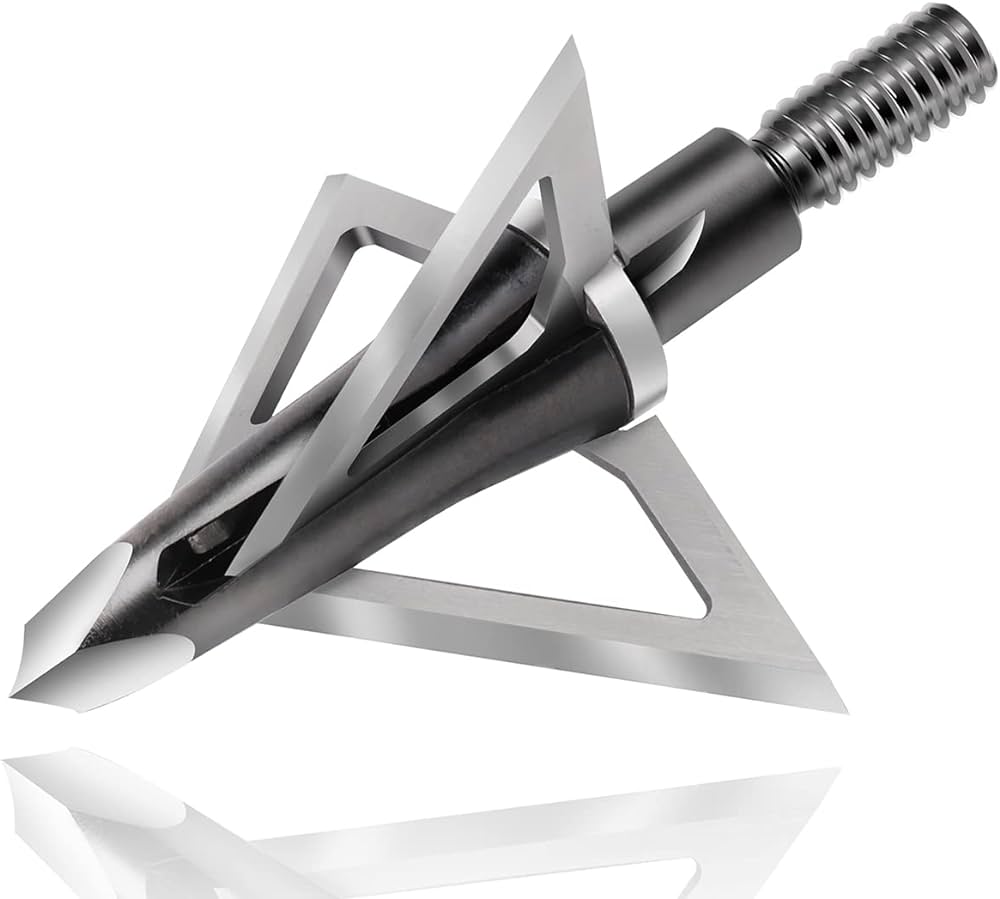
Before we dive into the specifics of crossbow broadheads, let’s first establish a foundational understanding of these crucial hunting accessories.
What is a Broadhead?
A broadhead is the razor-sharp tip that attaches to the end of an arrow or bolt. It is designed to inflict maximum damage upon impact, causing significant hemorrhaging and tissue trauma that leads to a swift and ethical kill.
Types of Broadheads
There are three primary types of broadheads:
- Fixed-Blade Broadheads: As the name suggests, these broadheads feature fixed blades that remain in an open position during flight and upon impact. Fixed-blade broadheads are known for their durability and consistent performance.
- Mechanical Broadheads: These broadheads have blades that remain closed during flight but deploy upon impact, creating a larger cutting diameter. Mechanical broadheads are designed to enhance penetration and wound channels.
- Hybrid Broadheads: Combining elements of both fixed-blade and mechanical designs, hybrid broadheads offer a balance of penetration and cutting diameter, often with deployable blades or sliders.
Each type of broadhead has its advantages and disadvantages, making it crucial to choose the right option based on your hunting preferences, shot angles, and the specific game you’re pursuing.
Factors to Consider When Choosing Crossbow Broadheads
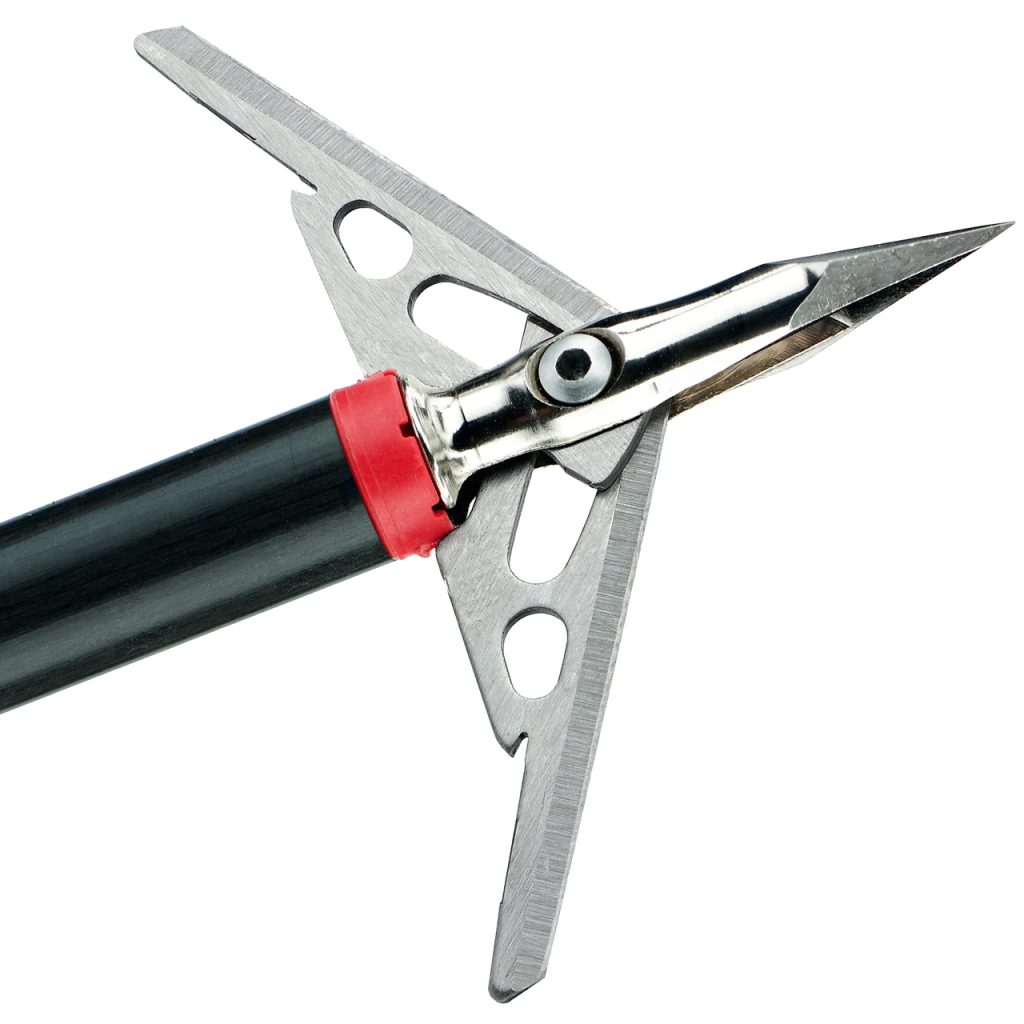
When selecting the best broadhead for deer hunting with a crossbow, several factors come into play:
- Crossbow Speed and Kinetic Energy: Crossbows can generate significantly higher speeds and kinetic energy compared to traditional vertical bows. This increased power demands broadheads that can withstand the intense forces and deliver reliable performance.
- Shot Angle and Terrain: The angle at which you’ll be taking shots and the terrain you’ll be hunting in can influence the type of broadhead you choose. Fixed-blade broadheads may excel in steep or obstructed shots, while mechanical broadheads can excel in open terrain with longer shooting distances.
- Penetration and Blood Trailing: Effective penetration is crucial for a clean kill, while ample blood trailing can aid in tracking and recovering your quarry. Consider broadheads that balance these two factors based on your hunting preferences.
- Durability and Sharpness: A durable broadhead that can withstand the rigors of hunting and maintain its sharpness is essential for consistent performance and ethical kills.
- Personal Preference and Confidence: Ultimately, your choice of broadhead should be one that you have confidence in and feel comfortable using. Personal preference plays a significant role in ensuring your success in the field.
Top Crossbow Broadheads for Deer Hunting
Now that we’ve covered the basics, let’s dive into our top picks for the best crossbow broadheads for deer hunting:
1. Rage Hypodermic Crossbow Broadheads

- Type: Mechanical
- Cutting Diameter: 2 inches (deployed)
- Weight: 100 grains
The Rage Hypodermic Crossbow Broadheads are designed specifically for the high speeds and kinetic energy generated by modern crossbows. These mechanical broadheads feature a slick, aerodynamic design that promotes excellent accuracy and penetration. Upon impact, the stainless steel blades deploy to create a massive 2-inch cutting diameter, resulting in devastating wound channels and ample blood trails.
Pros:
- Designed for crossbow speeds and kinetic energy
- Aerodynamic design for accuracy and penetration
- Massive 2-inch cutting diameter when deployed
- Stainless steel blades for durability and sharpness
Cons:
- Mechanical design may be less forgiving on marginal hits
- Blade deployment requires sufficient impact force
2. Sevr Titanium Crossbow Broadheads
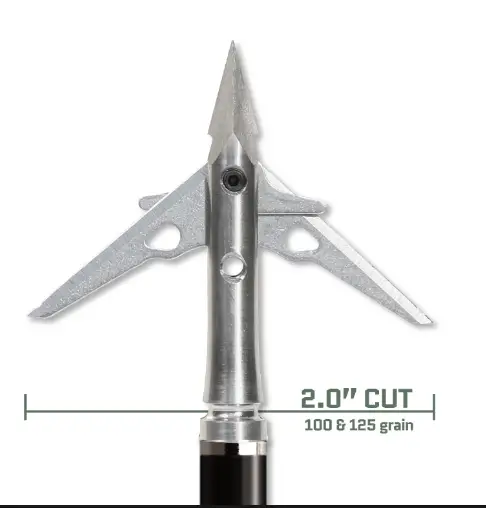
- Type: Fixed-Blade
- Cutting Diameter: 1.5 inches
- Weight: 125 grains
The Sevr Titanium Crossbow Broadheads are a top-of-the-line fixed-blade option designed to withstand the extreme forces generated by high-speed crossbows. These broadheads feature titanium ferrules and stainless steel blades, offering exceptional durability and sharpness. The 1.5-inch cutting diameter and chisel-tip design promote deep penetration and reliable performance on a variety of shot angles.
Pros:
- Titanium ferrules and stainless steel blades for durability
- Chisel-tip design for deep penetration
- Consistent performance on various shot angles
- Reliable fixed-blade design
Cons:
- Smaller cutting diameter compared to some mechanical options
- Fixed-blade design may require more precise shot placement
3. Excalibur Boltcutter Broadheads
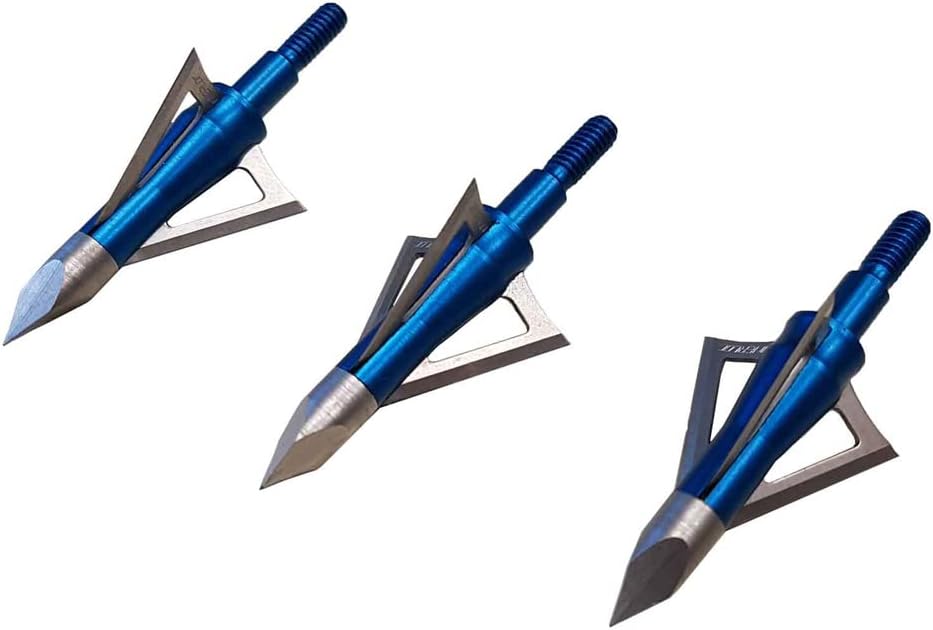
- Type: Hybrid
- Cutting Diameter: 1.5 inches (fixed), 2 inches (deployed)
- Weight: 100 grains
The Excalibur Boltcutter Broadheads combine the best of both worlds with a hybrid design that features fixed blades and deployable sliders. The fixed blades offer reliable performance and penetration, while the deployable sliders increase the cutting diameter to a massive 2 inches upon impact. This combination makes the Boltcutter a versatile choice for crossbow hunting, delivering both accuracy and devastating wound channels.
Pros:
- Hybrid design with fixed blades and deployable sliders
- Massive 2-inch cutting diameter when deployed
- Reliable performance and penetration
- Versatile for various shot angles and distances
Cons:
- Deployment mechanism may add complexity
- Slightly heavier weight compared to some options
4. Grim Reaper Razortip Crossbow Broadheads

- Type: Fixed-Blade
- Cutting Diameter: 1.5 inches
- Weight: 100 grains
The Grim Reaper Razortip Crossbow Broadheads are a popular fixed-blade option designed specifically for crossbow hunting. These broadheads feature razor-sharp blades made from stainless steel and a reinforced ferrule for added strength and durability. The cutting diameter of 1.5 inches and the chisel-tip design promote deep penetration and reliable performance, even at high crossbow speeds.
Pros:
- Reinforced ferrule for added strength and durability
- Razor-sharp stainless steel blades
- Chisel-tip design for deep penetration
- Reliable fixed-blade design
Cons:
- Smaller cutting diameter compared to some mechanical options
- Fixed-blade design may require more precise shot placement
5. Spitfire MAXX Crossbow Broadheads
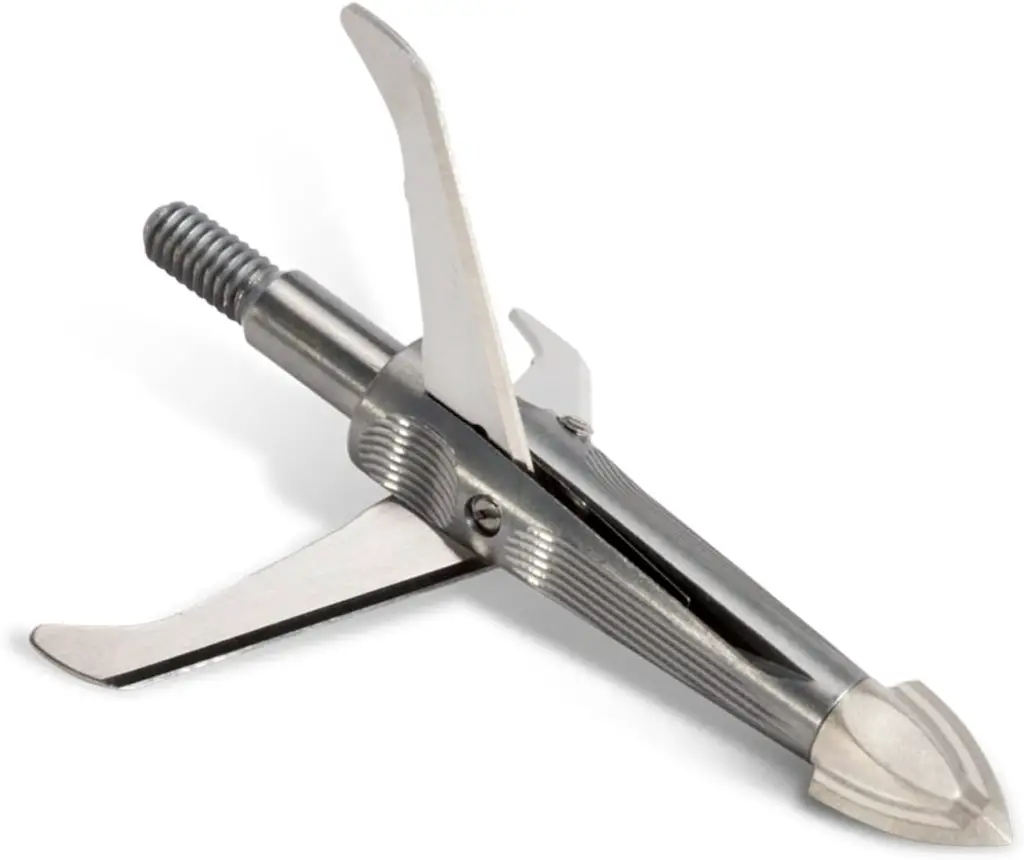
- Type: Mechanical
- Cutting Diameter: 1.5 inches (deployed)
- Weight: 100 grains
The Spitfire MAXX Crossbow Broadheads are a top-performing mechanical option designed specifically for crossbow hunting. These broadheads feature a sleek, aerodynamic design for improved accuracy and a compact profile that promotes deep penetration. Upon impact, the razor-sharp blades deploy to create a 1.5-inch cutting diameter, ensuring devastating wound channels and ample blood trails.
Pros:
- Aerodynamic design for accuracy and penetration
- Razor-sharp deployable blades
- Compact profile for deep penetration
- Reliable mechanical design
Cons:
- Smaller cutting diameter compared to some options
- Mechanical design may be less forgiving on marginal hits
Comparison Table
To help you quickly compare the key features of these top crossbow broadheads, we’ve compiled a handy comparison table:
| Broadhead | Type | Cutting Diameter | Weight | Key Features |
|---|---|---|---|---|
| Rage Hypodermic | Mechanical | 2 inches (deployed) | 100 grains | Designed for crossbow speeds, massive cutting diameter, stainless steel blades |
| Sevr Titanium | Fixed-Blade | 1.5 inches | 125 grains | Titanium ferrules, stainless steel blades, chisel-tip design |
| Excalibur Boltcutter | Hybrid | 1.5 inches (fixed), 2 inches (deployed) | 100 grains | Fixed blades and deployable sliders, versatile design |
| Grim Reaper Razortip | Fixed-Blade | 1.5 inches | 100 grains | Reinforced ferrule, razor-sharp stainless steel blades, chisel-tip design |
| Spitfire MAXX | Mechanical | 1.5 inches (deployed) | 100 grains | Aerodynamic design, compact profile, razor-sharp deployable blades |
Setting Up and Tuning Your Crossbow for Broadheads
Once you’ve selected your preferred crossbow broadhead, it’s crucial to properly set up and tune your crossbow to ensure optimal performance and accuracy. Here are some essential steps to follow:
- Broadhead Selection and Setup: Choose broadheads that are compatible with your crossbow’s specifications, such as bolt size and weight recommendations. Follow the manufacturer’s instructions for properly installing the broadheads onto your bolts.
- Paper Tuning: Paper tuning is a technique used to ensure your bolts are flying true and straight. By shooting through a paper frame at various distances, you can identify any potential issues with your crossbow’s tune or the broadhead’s alignment.
- Sight Adjustment: After paper tuning, you may need to adjust your crossbow’s sights to account for the different point of impact (POI) of the broadheads compared to field points or practice tips.
- Practicing with Broadheads: It’s essential to practice shooting with your chosen broadheads before heading into the field. This will help you gauge their accuracy, trajectory, and performance, as well as build confidence in your setup.
- Maintaining Sharpness: Proper maintenance and sharpening of your broadheads are crucial for ensuring consistent performance and ethical kills. Follow the manufacturer’s recommendations for sharpening techniques and tools.
By taking the time to properly set up and tune your crossbow with your chosen broadheads, you’ll increase your chances of success in the field and ensure a more ethical and humane hunting experience.
Shot Placement and Recovery Tactics
While the choice of broadhead is paramount, proper shot placement and recovery tactics are equally crucial for successful deer hunting with a crossbow. Here are some key considerations:
1. Shot Placement
The ideal shot placement for a deer is the vital area, which includes the heart and lungs. This shot maximizes the chances of a quick and ethical kill while also providing ample blood trails for recovery. However, shot angles and positioning can vary, and it’s essential to be prepared for different scenarios.
Quartering Away Shots: For quartering away shots, aim slightly forward of the shoulder to increase the chances of hitting the vital area and maximize penetration.
Quartering Towards Shots: For quartering towards shots, aim behind the shoulder to catch the offside lung and potentially the heart, ensuring a lethal shot.
Broadside Shots: For broadside shots, aim just behind the shoulder, targeting the heart and lungs for a clean, ethical kill.
2. Blood Trailing
Effective blood trailing is crucial for recovering your deer after a successful shot. Here are some tips for maximizing your chances of recovery:
- Wait at least 30 minutes before starting your trail, allowing the deer to expire and reducing the risk of pushing it further.
- Bring a trained tracking dog or enlist the help of an experienced tracker if available.
- Look for broken branches, disturbed vegetation, and other signs of the deer’s path in addition to blood trails.
- Be patient and thorough, as a well-placed shot can still result in minimal blood trails initially.
3. Recovering and Field Dressing
Once you’ve located your deer, it’s essential to handle the recovery and field dressing process with respect and care. Here are some best practices:
- Approach the deer cautiously, ensuring it has expired before getting too close.
- Use proper field dressing techniques, such as ensuring a clean and efficient removal of the internal organs.
- Properly cool and transport the meat to prevent spoilage and maintain quality.
- Consider seeking the assistance of an experienced hunter or mentor if you’re new to field dressing.
By combining the right broadhead selection, proper shot placement, and effective recovery tactics, you’ll increase your chances of a successful and ethical deer hunt with your crossbow.
Frequently Asked Questions (FAQs)
Q: What’s the difference between fixed-blade, mechanical, and hybrid broadheads?
A: Fixed-blade broadheads have blades that remain in an open position during flight and upon impact. Mechanical broadheads have blades that deploy upon impact, creating a larger cutting diameter. Hybrid broadheads combine elements of both, often with fixed blades and deployable sliders.
Q: Which type of broadhead is better for crossbow hunting?
A: There is no definitive “best” type of broadhead for crossbow hunting. Each type has its advantages and drawbacks, and the choice depends on factors such as shot angles, terrain, and personal preference. Many crossbow hunters prefer mechanical or hybrid broadheads for their increased cutting diameters and penetration capabilities.
Q: How important is broadhead weight when hunting with a crossbow?
A: Broadhead weight is an important consideration when hunting with a crossbow. Heavier broadheads can improve penetration and kinetic energy transfer, but they may also affect accuracy and trajectory. It’s crucial to choose a broadhead weight that is compatible with your crossbow’s specifications and preferred bolt weight.
Q: Can I use the same broadheads for both compound bow and crossbow hunting?
A: While some broadheads may be suitable for both compound bow and crossbow hunting, it’s generally recommended to use broadheads specifically designed for crossbows. Crossbows generate higher speeds and kinetic energy, demanding broadheads that can withstand these increased forces.
Q: How do I properly maintain and sharpen my broadheads?
A: Proper maintenance and sharpening are essential for ensuring consistent performance and ethical kills. Follow the manufacturer’s recommendations for sharpening techniques and tools. Additionally, inspect your broadheads regularly for any damage or dulling, and replace them as needed.
Q: What are some crucial recovery tactics for deer hunting with a crossbow?
A: Crucial recovery tactics include waiting at least 30 minutes before trailing, utilizing trained tracking dogs or experienced trackers, looking for signs beyond just blood trails, and approaching the downed deer cautiously. Proper field dressing techniques and meat handling are also essential.
Conclusion
Deer hunting with a crossbow is a thrilling and rewarding pursuit, but it also carries the responsibility of ensuring ethical and humane kills. Choosing the right broadhead is a critical component of this equation, as it directly impacts accuracy, penetration, and lethality.
In this comprehensive guide, we’ve explored the different types of broadheads, the key factors to consider when selecting them, and our top picks for the best crossbow broadheads for deer hunting. From the Rage Hypodermic’s massive cutting diameter to the Sevr Titanium’s durable design, and the versatility of the Excalibur Boltcutter, there’s a broadhead option to suit every hunter’s preferences and needs.
Remember, proper shot placement, effective blood trailing, and respectful recovery techniques are equally crucial for a successful and ethical hunt. By combining the right broadhead selection with these essential skills, you’ll increase your chances of a clean, humane kill and ensure a memorable and rewarding hunting experience.
So, take the time to research and invest in the best crossbow broadheads for your needs, practice diligently, and always prioritize ethical hunting practices. With the right tools and mindset, you’ll be well on your way to becoming a responsible and accomplished deer hunter, reveling in the thrill of the chase while upholding the highest standards of sportsmanship and conservation.

